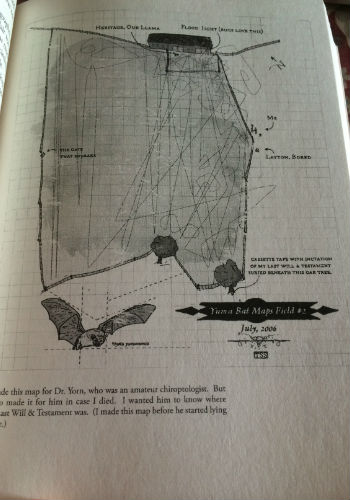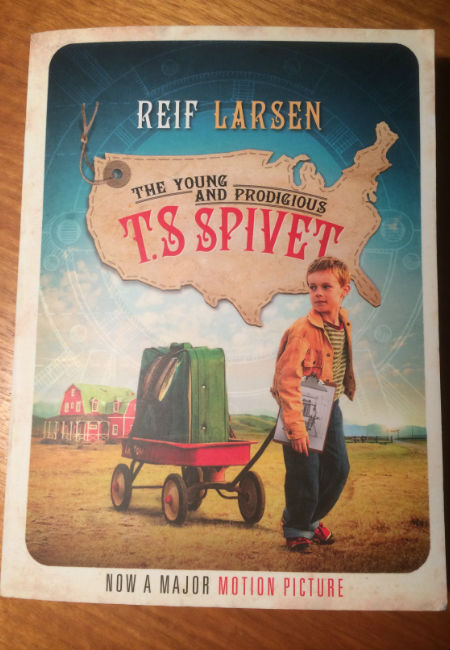The urge to belong is a powerful impulse.
It impels us to do everything from mimicking certain patterns of speech, adopting different hair and clothing styles, seeking out fora both online and off that we can actively participate in, and giving up all manner of affectations, luxuries or vice, all in the name of seeking to be part of something greater than ourselves.
It’s an unarguably integral part of our identity and hence it’s lack, or the perception of its absence, can be debilitating, especially if you’re a 12 year old boy like The Young and Prodigious T. S. Spivet growing up on a ranch out in the remote reaches of Montana “just north of the Divide”.
T.S., short for Tecumseh Sparrow – the distinctive first name has been handed down through his family ever since his Finnish great-great-grandfather arrived in the west of America back in the mid 19th century – is a preternaturally-gifted young man, possessed of a ever-active scientific curiosity that sees the world not a big picture entity but a series of connected building blocks, all of which he seeks to understand by the maps and diagrams he spends every spare moment of time creating.
So prodigious is this young scientist-in-the-making’s output that he has filled his bedroom with three walls of colour-coded notebooks and measuring instruments, marking him as an oddity in a family with a taciturn, almost emotion-less rancher father Tecumseh Elijah, an older sister Gracie obsessed with making it to the bright lights and big city, any city will do, and a much-lamented older dead brother rancher-tob-be Layton, whose premature death is a continuing source of agony and introspection for T.S.
And while his mother Clair Linnaker Spivet is a scientist, in search of a mysterious and likely non-existent species of beetle, which at least explains partly where his rurally-abherrant interests sprang from, , she is a remote, absent-minded mother who drifts in and out of T.S.’s insular life with very little in the way of meaningful contact.
Hence while he technically belongs to the Spivet family and the Coppertop ranch they call home, he feels, like many people drifting into adolescence (and even those well past it) that he is an anomaly, a “one of these things is not like the other” example from Sesame Street, his presence sticking out like a sore thumb in a manner that must be painfully obvious to anyone who bothers to take even a cursory glance at his life.
And so when the Smithsonian from faraway Washington D.C., an institution that he venerates both for its scientific rigour and the lifelong certainty that it will provide the sense of truly belonging that he has been missing all his life, calls and says it wants to bestow the prestigious Baird Award on him, based on drawings submitted by his mentor Dr Terence Yorn, he is thrilled.
Overwhelmed yes like any 12 year old face with an enormous opportunity far outside their normal sphere of experience would be, but thrilled nonetheless, convinced this is an unmissable chance to find a like-minded group of people, to belong in a way that has eluded him up till this point.
And so in the early hours of one morning, armed with a soon-realised pitiable lack of provisions and his most valued scientific apparatus securely tucked away in his suitcase, he leaves the ranch to journey across America, first via train and then big rig, to take up residence with what he knows in his child-like, deeply-sensitive and thoughtful heart of hearts will be his new family, people who will understand, appreciate and love him in a way that his biological one seems to have failed to do.
The Young and Prodigious T. S. Spivet thus may sound overall like a fantastical larger-than-life epic, one that owes little to the every day concerns of people simply trying to fit in to their small ill-fitting patch of the world, but Reif Larsen, who is possessed of a gift for prose that sparkles with wit, whimsy and general poetically-expressed insight, invests his debut novel with a lovely fresh humanity that will make sense to anyone with even a passing sense of their own self-awareness.
The concerns of T.S. are universal ones, and while they find expression in the book in terms of the sometimes eccentric, almost literal world of an intellectually gifted boy from Montana who isn’t like his family or peers and thus sees the world through wise old eyes that separate him from the pack, they are instantly relatable, thanks to Larsen’s ability for bringing them down to their essence.
We see how T.S. is convinced he doesn’t belong on the land because his father doesn’t seek to involve him in its nurture, something with which he has no real affinity in any event, how he pines for his lost brother and feels responsible for his death and how he perceives Gracie’s flippancy and his mother’s emotional remoteness as rejections of some kind or another.
But through the course of the book, it becomes clear these relationships aren’t quite what they appear, with many things happening outside of T.S. limited view of the world; he is so articulate, and accomplished that you have to be reminded at times he is just a young boy, not yet ventured into the turbulent world of the teenage male and not fully aware of the dynamics at play around him.

One relationship that is particularly illuminated towards the end of the book is that of T.S. and his seemingly un-relatable father who he discovers may be more invested in the welfare of his son in ways that are immediately apparent.
“A few steps behind him, holding his cowboy hat in his hands, was my father.
“He was the most glorious sight I had ever seen, and in that single instant, my conception of my father was forever changed, forever inflected with the expression on his face as he walked into that room inside the U.S. Capitol and spotted me sitting in that chair. A thousand diagrams of Dr. Ekman’s facial units could not capture the relief, the tenderness, the deep, deep love, bound up in my father’s face. And not just that: I realized that these emotions had always been there, they had just been hidden behind the curtains of his silent akimbo. Now, in a single moment, his cards were on the table and I knew. I knew.” (pp 369-370)
What gives this delightful, emotionally-resonant and exquisitely well-written book so much power is that for all the grand adventures that T.S. goes on, and for all the maps, diagrams and side bars that fill the edges of the book (giving both further insight into the young man’s world and making the book an object of unique pictorial beauty in and of itself), is that it is, in essence, a universally-understandable tale of one person’s quest to find a place to which they can belong.
That T.S realises by the end of the book that he has always belonged with his family, and may not yet be ready to belong completely to the fabled once-promised land of the very-adult scientific community he once uncritically revered, is drawn out with such sensitivity, sweetness and mostly matter-of-fact sentimentality that you can’t help but warm to this impressive young man, and the remarkable journey, both exterior and interior, that he undertakes.
